Navigating the maze of fitness advice can feel like a workout in itself, and trying to separate fact from fitness myth causes many people to feel more lost than ever.
Every corner of the internet offers a new fitness myth or quick-fix workout promising unreal results. Amidst this chaos, claims debunked by science but still widely believed and propagated — stands as a testament to the power of clickbait headlines and a lack of integrity in the fitness industry. Understanding the truth behind each fitness myths is crucial, not only for achieving your fitness goals but for maintaining a balanced and healthy lifestyle. Whether it’s the notion that muscle soreness equals a successful workout, or that a calorie deficit is all there is to know about diet, the misconceptions are plentiful and misleading.
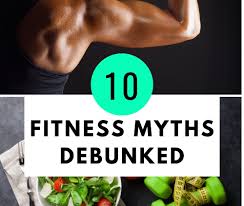
This article aims to shatter the most prevalent fitness myth that have long misled fitness enthusiasts and beginners alike. From the false promise of spot reduction in fat loss to the misconceptions surrounding strength training, cardio, and nutrient timing, we’ll debunk each fitness myth with facts and expert insights. We delve into why more sweat doesn’t always mean a better workout, why you don’t have to exercise every day to see results, and why the timing of your protein intake might not be as crucial as you’ve been led to believe.
By dissecting each fitness myth, our goal is to arm you with the knowledge to make informed decisions about your fitness journey, steering clear of the pitfalls that lead to disappointment and frustration.
Fitness Myth 1: Exercise Success Equals Muscle Soreness

Understanding Muscle Soreness vs. Muscle Growth
Muscle soreness after a workout is often seen as a badge of honour, a sign that you’ve pushed your limits and are on the path to gains. However, this fitness myth might not paint the full picture of muscle development. Muscle soreness results from microscopic tears in your muscle tissues, initiating an inflammatory response that aids in the healing process.
This is a natural part of the muscle-building journey, but it’s not the sole indicator of an effective workout. In fact, as your body adapts to the exercise, you might find that the same activities cause less soreness over time. This adaptation doesn’t mean your workouts are less effective; rather, it indicates that your muscles have grown stronger and more capable of handling the stress of exercise without significant damage.
It’s crucial to understand that muscle growth occurs not during the workout itself, but in the repair phase that follows. This period of rest and refuelling allows your muscles to heal and grow back stronger, preparing you for future workouts with less effort. Skipping this crucial recovery period could not only stunt your progress but also lead to longer recovery times through injury. Working out with tired muscles and a fatigued mind increases the risk of poor form and overuse injuries, potentially reversing your fitness progress.
The Importance of Recovery and Rest Days
Rest days are just as important as your training days. They provide your body—and mind—the necessary time to recover from the stress of workouts. Rest prevents burnout and ensures you’re ready to give your all in your next session. Moreover, taking regular breaks allows your body to adapt to your training, growing stronger and fitter. This adaptation is critical for making the next workout count more than if you had skipped the recovery period.
During rest days, your muscles undergo a crucial repair process. Cells called fibroblasts work to heal the tissue, resulting in stronger muscles. Additionally, rest allows your body to replenish glycogen stores, which are depleted during exercise. Glycogen is essential for muscle function, even when you’re not working out. Without adequate rest, you risk muscle fatigue and soreness, which can hamper your performance and motivation in the long run.
Regular rest is essential not just for physical recovery but for mental well-being too. Exercise puts a strain on both the body and mind, and without proper rest, you might find yourself mentally exhausted and more prone to making mistakes during training. This mental fatigue can lead to a lack of motivation and enjoyment in activities you typically love. Incorporating rest days into your routine allows your body and mind to reset, recharge, and recover, ensuring you’re always ready to tackle your next workout with enthusiasm.
In conclusion, while muscle soreness can be a part of the fitness journey, it’s not the definitive measure of a successful workout. Understanding the difference between muscle soreness and muscle growth, along with the vital role of recovery and rest days, is key to achieving your fitness goals safely and sustainably.
Fitness Myth 2: Strength Training Leads to Bulkiness
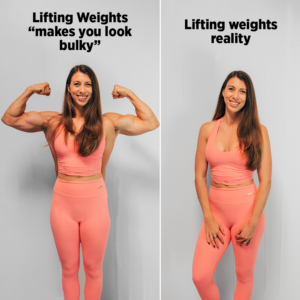
A common fitness myth that deters many, especially women, from embracing strength training is the fear of becoming too bulky. Let’s dive into the facts and debunk this myth by understanding the intricate process of muscle growth and the differences in muscle development between genders.
The truth about muscle growth and body composition
Contrary to popular belief, regular strength training does not automatically result in a bulky appearance. Achieving a heavily muscular physique requires a high volume of training, consistent effort over a prolonged period, and a specific nutritional strategy. To gain significant muscle mass, one would typically need to engage in weightlifting sessions around 5-6 times a week, lasting 60-90 minutes each, and this regimen would need to be sustained over an extended timeframe, often spanning 1-2 years. Moreover, a caloric surplus—consuming more calories than your body expends—is essential to provide the extra energy required for muscle growth and overall mass gain.
For those aiming for a lean and toned physique, it’s crucial to focus on full-body workouts that engage multiple muscle groups. This approach helps distribute the training stimulus across the body, promoting balanced muscle growth and preventing an overly muscular appearance. Additionally, maintaining your current weight or creating a calorie deficit, where your body operates within maintenance calories or consumes fewer calories than it expends, is pivotal. This strategy prioritises fat loss while preserving existing muscle mass, steering clear of the excess calorie surplus necessary for substantial muscle growth.
Strength training is an important component of any fitness program, whether the goal is bulking up or getting toned. Muscle definition, which contributes to a toned look, requires muscle mass—something that cannot be achieved without strength training. Furthermore, strength training can boost your metabolic rate, meaning your body will burn calories more quickly, aiding in weight control or loss.
Gender differences in muscle development
Women athletes are known to be less strong and powerful than equally trained men, with muscle strength of women typically reported in the range of 40 to 75% of that of men. Gender differences are still evident when power per kg of body mass is considered, and the difference in absolute strength between genders appears more evident in the upper body compared to the lower body. This disparity can be attributed to differences in muscle morphology and lean body mass (LBM) distribution between men and women.
However, it’s important to note that training works similarly for both men and women. No exercise or training method is off-limits based on gender unless there are specific injuries or personal preferences at play. Men and women have similar muscle tissue, and while there are some differences in the results that might be achieved due to varying levels of endurance and strength fibres, as well as hormonal influences, these differences do not necessitate different training approaches. Hormonal fluctuations in women can influence exercise results, but this simply means adjustments might be needed to achieve goals, not a complete overhaul of training methods.
In conclusion, strength training does not inevitably lead to bulkiness. With the right approach to training and nutrition, individuals can achieve a lean, toned physique that aligns with their fitness goals. Understanding the science behind muscle growth and recognising the gender-specific factors in muscle development can empower everyone to embrace strength training without fear.
Fitness Myth 3: Specific Exercises Can Target Fat Loss in Certain Areas
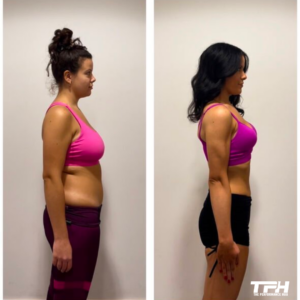
Debunking the Spot Reduction Myth
Despite popular belief and many fitness advertisements, spot reduction—the idea that you can target fat loss in specific body areas through certain exercises—is not supported by scientific evidence. Research has consistently shown that our muscles utilise energy from fat stores spread throughout the body, not just from the area being exercised. This process involves lipolysis, where triglycerides are broken down into glycerol and free fatty acids, which then circulate throughout the body and are used as energy in various locations, not just beneath the active muscles.
A comprehensive study involving over 1,100 participants revealed that localised muscle training did not lead to fat loss in specific areas. This indicates that exercising certain body parts does not reduce fat in those specific parts. Further, a randomised 12-week clinical trial comparing abdominal resistance training with dietary changes to diet alone found no significant difference in belly fat reduction between the two groups, debunking the myth of spot reduction.
Strategies for Overall Body Fat Reduction
To effectively reduce body fat, a holistic approach involving a combination of diet and exercise is essential. Engaging in regular physical activity helps to burn calories and can lead to overall fat loss. Aerobic exercises like brisk walking, cycling, or swimming are particularly effective when performed for at least 30 minutes on most days of the week. These activities help increase the total number of calories burned, contributing to a calorie deficit necessary for weight loss.
Strength training also plays a crucial role in fat reduction by preserving lean muscle mass, which can increase resting metabolic rate—the rate at which your body burns calories at rest. Research shows that resistance training can decrease body fat by an average of 1.46% and is more effective at reducing body fat than aerobic exercise alone. Incorporating full-body workouts that engage multiple muscle groups can ensure balanced muscle growth and prevent the bulky appearance that many fear.
For those seeking targeted improvements, while it’s not possible to lose fat exclusively from desired body parts, strengthening exercises can enhance the appearance of these areas by building muscle and improving overall body composition. This approach, combined with a consistent aerobic routine, can lead to visible changes and more defined muscles throughout the body.
In conclusion, while specific exercises do not target fat loss in certain areas, a combination of strength training and aerobic exercises, along with a balanced diet, can effectively reduce overall body fat and improve body composition. Consulting with fitness professionals can provide tailored advice to meet individual goals and ensure safe and effective training.
Fitness Myth 4: More Sweat Indicates a Better Workout
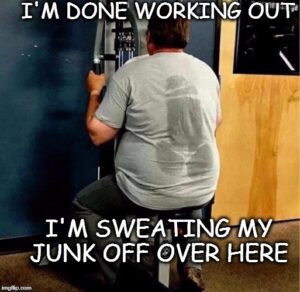
Understanding the Role of Sweat in Exercise
Sweating is a natural physiological response that helps regulate body temperature by releasing water and salt, which evaporates to cool you down. While it’s true that activities such as Bikram yoga or intense cardio can make you sweat profusely, sweating does not necessarily correlate with the number of calories burned. For instance, a 90-minute Bikram yoga session may result in a lot of sweat but only accounts for the calorie burn equivalent to walking briskly for the same duration. Additionally, you can also burn calories in low-sweat scenarios like swimming or lifting light weights in cooler environments.
If you were to watch me perform a light warm up, I’ll be sweating. And if I were to run a PB 5k.. I’d be sweating the same amount. This fitness myth has been around since the dawn of time, and possibly contributed to the popularity of things like hot yoga and saunas!
Interestingly, as you become fitter, your body becomes more efficient at cooling itself, leading to earlier and more intense sweating during physical activities. This adaptation allows you to maintain a higher intensity and longer duration during workouts without overheating.
Other Indicators of an Effective Workout
While sweat can be an indicator of physical exertion, it should not be the sole measure of workout effectiveness. Other metrics such as heart rate, perceived exertion, and post-workout muscle soreness provide more comprehensive insights into your fitness progress. For example, the Borg Rating of Perceived Exertion (RPE) scale considers individual physiological responses to exercise, offering a more subjective measure of intensity.
Moreover, tracking improvements in strength, endurance, and overall fitness levels can be more indicative of your progress. Increases in the number of repetitions, the ability to lift heavier weights, or enhancements in cardiovascular endurance are tangible indicators that your workouts are effective. Additionally, changes in body composition, such as increased muscle mass and decreased fat percentage, can provide a clearer picture of the benefits of your fitness regimen.
In conclusion, while sweating is a natural and essential body function during exercise, it is not a definitive indicator of workout effectiveness. Understanding the broader context of physical fitness and incorporating various performance metrics can lead to a more accurate and fulfilling fitness journey.
Fitness Myth 5: High-Intensity Workouts Are the Only Way to See Results

The Benefits of Varied Workout Intensities
High-Intensity Interval Training (HIIT) is renowned for its efficiency in burning calories and enhancing cardiovascular fitness in a short amount of time.
By alternating between high-intensity aerobic exercises and short rest intervals, HIIT sessions can vary from 10 to 45 minutes and are proven to burn approximately 30% more calories than other forms of exercise. Moreover, the afterburn effect of HIIT means you continue to burn calories even after your workout ends, making it a powerful tool for fat loss.
As you read that, it sounds impressive right? Well it’s important to note a couple of little details about this fitness myth. Firstly, the word ‘proven’ needs to be put into context. All it means is that in a study they found people that worked out harder, burned more calories in less time (not exactly shocking is it?).
But what’s missing is how much more (not much) and how any calories are actually burned post exercise (again, not much). Once you factor in the potential downside of HIIT workouts you’ll quickly realise that while they can be useful, they’re far from the only way to see results. And thus are another fitness myth.
However, it’s crucial to understand that HIIT is not the sole method for achieving fitness results. Low-intensity exercises also play an essential role in a balanced fitness regimen. These activities, such as long slow distance (LSD) cardio, help create and maintain an aerobic base, crucial for improving overall cardiovascular health and enabling your body to burn fat more effectively even during rest.
Incorporating Balance and Recovery into Your Routine
Balancing high-intensity workouts with adequate recovery and lower-intensity exercises is key to long-term fitness success. Recovery periods are not just downtime but are essential for muscle and nervous system repair, joint and tendon recovery, and overall performance enhancement. Incorporating both passive and active recovery strategies, such as stretching, massage, or light activities like swimming or hiking, helps maintain flexibility and strength while preventing overtraining.
For those engaged in regular high-intensity training, it is vital to plan recovery times effectively. This includes immediate recovery post-workout, recovery between sessions, and longer-term recovery periods after training cycles. Also, alternating the intensity of workouts throughout your training schedule can prevent injury and avoid the plateau effect, ensuring continual progress in your fitness journey.
In conclusion, while high-intensity workouts are effective for quick results and increased calorie burn, they should be part of a broader, well-rounded exercise regimen that includes varied intensities and adequate recovery to ensure sustainable fitness progress and overall health.
Fitness Myth 6: You Must Workout Every Day to Achieve Fitness Goals

The Importance of Rest Days in a Fitness Regimen
No pain no gain, right? Wrong.
The notion that you cannot take a break is possibly the most harmful fitness myth.
Rest days are critical to any successful fitness program, providing necessary recovery time for your muscles and mind. When you allow your body to rest, you’re not only preventing injuries but also improving your overall performance for future workouts. Muscles develop during their repair phase, which occurs when you’re resting. This crucial downtime helps your muscles to heal from the microscopic tears that occur during exercise, ultimately making them stronger and more efficient for the next workout.
The notion that you must always do more in order to achieve results is a common fitness myth touted by those looking to sell you.. more! It’s important to debunk this fitness myth and focus on the idea of quality > quantity when it comes to exercise.
Moreover, rest days help prevent the common pitfalls of overtraining, which can include prolonged muscle soreness, burnout, and even a decrease in performance. By integrating rest days into your routine, you ensure that each workout is performed with maximum effort and safety, leading to more consistent progress.
Finding the Right Workout Frequency for Your Body
Determining the ideal workout frequency is essential and should be tailored to individual fitness goals, whether it’s weight loss, muscle gain, or maintaining a healthy lifestyle. For general health, the World Health Organisation recommends at least 150 minutes of moderate aerobic activity or 75 minutes of vigorous activity per week, supplemented by muscle-strengthening activities on two or more days.
However, if your goal is more specific, like muscle building or significant weight loss, adjusting the frequency and intensity of workouts is crucial. For beginners, starting with two to three days of strength training per week is advisable, gradually increasing as your body adapts. Each session should include a mix of cardio, strength training, core work, and stretching to ensure a well-rounded approach.
It’s also beneficial to vary the intensity of workouts throughout the week to prevent plateauing and to keep your body guessing. This variation can include a combination of high-intensity interval training (HIIT) and moderate-intensity exercises to optimise fat loss and muscle gain.
Remember, listening to your body is key; if you feel overly fatigued or sore, it may be a sign to scale back and allow more time for recovery. By customising your workout schedule to include adequate rest and varying intensities, you’ll be able to maintain a balanced and sustainable fitness routine that respects your body’s limits and capabilities.
Fitness Myth 7: Fasted Cardio Leads to Faster Fat Loss

Examining the Science Behind Fasted vs. Fed Workouts
The concept of fasted cardio suggests that performing aerobic exercise on an empty stomach, typically after an overnight fast, can lead to increased fat burning. This fitness myth is based on the idea that low glycogen and insulin levels cause the body to increase fat oxidation for energy. Research indicates that while fasted cardio does increase fat oxidation acutely, it does not necessarily translate into greater overall fat loss.
A meta-analysis involving 273 participants across 27 studies confirmed that fasted cardio leads to higher immediate fat oxidation compared to fed cardio. However, the same studies showed no significant difference in long-term body composition changes between fasted and fed groups. This suggests that the timing of meals relative to exercise may not be as crucial for fat loss as previously thought, as long as calorie intake and expenditure are appropriately managed.
Further research in a controlled study with 20 women on a hypocaloric diet showed no significant difference in fat loss between those who exercised after eating and those who did not eat before exercising. This underscores the point that overall energy deficit is more critical than exercise timing for fat loss, and that fasted cardio is another example of a fitness myth.
Personalising Your Workout Timing for Optimal Results
While the broader evidence suggests that fasted cardio does not have a superior effect on fat loss, individual results can vary based on personal metabolism, lifestyle, and body composition. For example, some individuals might find that morning exercise helps them control appetite or fits better into their daily schedule, which can contribute to better adherence to a fitness regimen.
Moreover, the choice between fasted and fed exercise might also depend on personal health conditions. For instance, individuals with glucose regulation issues might benefit from fasted cardio, as it has been shown to improve insulin sensitivity and glucose tolerance. This doesn’t directly influence fat loss but can be crucial for overall metabolic health.
Ultimately, the best approach is to choose a workout timing that fits your lifestyle, preferences, and body’s responses. This personalisation ensures that you can stick with your exercise routine consistently, which is the most important factor for long-term fitness and health benefits.
Fitness Myth 8: Protein Intake Immediately After Workout Is Crucial

Debunking the Anabolic Window Myth
The concept of the “anabolic window,” a specific period post-exercise when nutrient intake supposedly has a superior effect on muscle recovery and growth, is a long standing fitness myth. This theory suggests that consuming protein and carbohydrates immediately after training is crucial for maximising muscle gains. However, recent studies challenge the necessity of this narrow time frame. Research indicates that the anabolic window might extend up to several hours post-exercise, debunking the idea that immediate intake is critical.
For instance, a study comparing the effects of protein supplementation before and after resistance training found no significant differences in muscle strength or body composition changes between groups, suggesting that the timing of protein intake may not be as critical as once thought. Furthermore, total daily protein intake and overall diet quality appear to play a more significant role in muscle health and recovery than the exact timing of protein consumption.
Understanding Protein Timing and Muscle Recovery
While the anabolic window may be another fitness myth, understanding protein timing can still benefit muscle recovery and growth. Protein serves as the building block for muscle repair. Essential amino acids, found in dietary proteins, are crucial for stimulating muscle protein synthesis, a necessary process for muscle recovery and growth.
It’s important to consider individual training states when planning protein intake. For those training in a fasted state, the timing of protein intake might be more critical to prevent excessive muscle protein breakdown and support recovery. In such cases, consuming protein soon after a workout can be beneficial. However, if a pre-workout meal was consumed, the urgency for post-workout nutrition diminishes, allowing for more flexibility in protein timing.
The effectiveness of protein timing is also influenced by the amount of protein consumed. Studies suggest that 20-40 grams of protein post-workout is sufficient to support muscle recovery and growth, regardless of the exact timing. This amount can typically be met through a single serving of a protein-rich meal or supplement, making it a practical guideline for most individuals engaged in resistance training.
In summary, while protein timing can play a role in optimising muscle recovery, especially in specific training conditions like fasted workouts, the overall daily protein intake and meal composition are equally, if not more, important. This perspective allows for more flexibility and personalisation in dietary planning, catering to individual preferences and lifestyles without compromising muscle recovery and growth.
Fitness Myth 9: Stretching Before Workouts Prevents Injuries
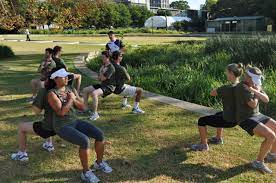
The Difference Between Dynamic and Static Stretching
Dynamic and static stretching serve different purposes in your fitness routine. A common fitness myth is that stretching will prevent soft tissue injuries, unfortunately this is not the case. While both are essential, understanding when and how to use them can significantly impact your performance and injury prevention. Dynamic stretching involves controlled movements that prepare your muscles, ligaments, and other soft tissues for performance and safety.
This type of stretching improves dynamometer-measured power as well as jumping and running performance. In contrast, static stretching, which involves holding a stretch without movement for 20 to 45 seconds, can increase flexibility but may also limit your body’s ability to react quickly, potentially reducing performance in activities that require speed and power.
Recommendations for a Safe and Effective Warm-Up
To prevent injuries and enhance your workout effectiveness, a proper warm-up routine is crucial. Start with 5 to 10 minutes of low- to moderate-intensity activity such as jogging or cycling. This initial phase increases your muscle temperature and blood flow, preparing your body for exercise. Following this, incorporate dynamic stretches to activate your muscles through a range of movements, which is essential for preparing your body for the dynamic nature of most sports and activities.
Static stretching, while beneficial for increasing overall flexibility, should ideally be saved for your cool-down routine to help maintain muscle length and prevent post-exercise soreness. Avoid static stretching before exercises requiring quick reactions or explosive power, as it may decrease your performance and increase injury risk by reducing muscle strength temporarily.
By adhering to these guidelines, you can ensure a warm-up that not only prepares you physically but also aligns with your body’s needs, enhancing both performance and safety.
Conclusion
Throughout this exploration, we’ve journeyed together to dispel each common fitness myth that, despite being widely accepted, stand on shaky scientific ground. From the fitness myth about soreness being synonymous with effectiveness, to the fitness myth surrounding strength training and bulkiness, and the fitness myth about fat loss and protein timing, we’ve armed ourselves with knowledge to navigate our fitness paths more wisely.
Our journey underscores the importance of approaching fitness with a holistic, informed perspective, ensuring our efforts align with scientifically-backed principles for health and wellness.
Embracing the truths we’ve unearthed allows us to foster a more inclusive, effective, and enjoyable fitness regimen—one that acknowledges the diversity of bodies, goals, and lifestyles. As we move forward, let us remain open to learning and adapting, guided not by a fitness myth but by a commitment to our well-being. Remember, the success of our fitness journey is measured not by adherence to unfounded claims but by our dedication to a balanced, informed approach to physical health and happiness.
Remember to check out our other Blog Articles HERE.
To find The Performance Hub Podcast CLICK HERE.
FAQs
What does an unhealthy obsession with exercise look like?
An unhealthy obsession with exercise, often referred to as compulsive exercise, is as hazardous as severe dietary restrictions or the misuse of diet aids like pills and laxatives. It can trigger eating disorders such as anorexia and bulimia, and lead to grave physical issues including kidney failure, heart attacks, and even death.
Is it possible for exercise to have negative effects?
Yes, exercise can have negative effects if not balanced with adequate rest. Rest is crucial as it helps the body recover and prepare for the next workout. Insufficient rest can result in diminished performance and health issues, essentially causing exercise efforts to backfire.
What is the most common error when starting a workout program?
The most common mistake when beginning an exercise program is doing too much too quickly. Attempting to compensate for inactive periods by overexerting yourself in initial workouts can be harmful. It’s important to start at a realistic level and gradually increase the intensity and duration of your workouts. Fitness myth.
Can over exercising be detrimental to health?
Yes, over exercising can severely impact health. It can suppress the immune system and increase the risk of osteoporosis and bone loss, particularly in women. Excessive training can also lead to heart damage and rhythm disorders, with individuals having genetic predispositions to cardiac issues being particularly at risk. Fitness myth.


